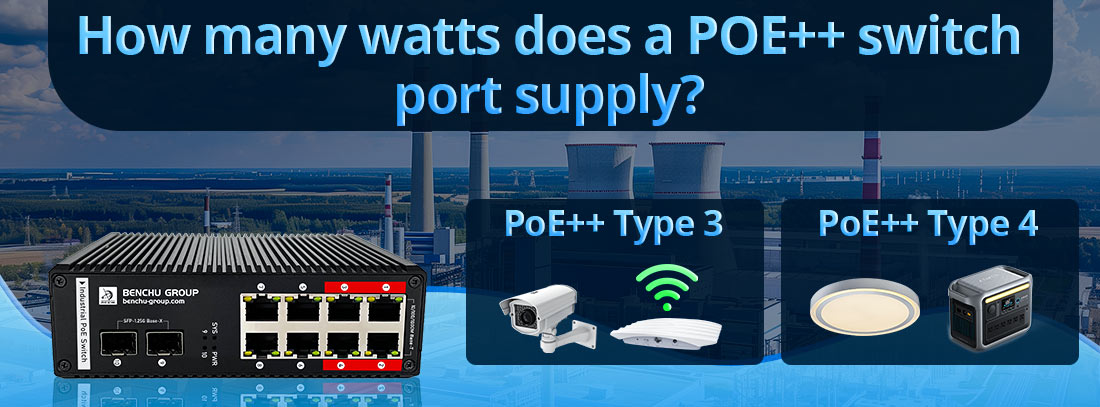
Un port de commutateur PoE++, conforme à la norme IEEE 802.3bt, fournit l'alimentation à deux niveaux en fonction du « Type » de PoE++ utilisé. Ces deux types (Type 3 et Type 4) fournissent des puissances maximales différentes pour prendre en charge une variété d'appareils haute puissance.
Voici un aperçu du fonctionnement de la fourniture d’énergie PoE++ :
1. PoE++ Type 3 (60 watts)
Puissance de sortie maximale : Le PoE++ de type 3 peut fournir jusqu'à 60 watts de puissance par port à l'extrémité de l'équipement d'alimentation électrique (PSE), tel qu'un Commutateur PoE++. Cela le rend idéal pour les appareils moyennement gourmands en énergie tels que les caméras PTZ haute résolution, les points d'accès sans fil (WAP) et certains types d'affichage numérique.
Puissance reçue par l'appareil alimenté (PD) : En raison des pertes de puissance dans le câblage, la puissance réelle reçue par l'appareil peut être d'environ 51 à 55 watts selon le type et la longueur du câble. Un câblage de haute qualité (tel que Cat6 ou Cat6a) permet de réduire les pertes de puissance, garantissant une puissance proche de 55 watts au niveau de l'appareil.
Exemples d'application : Les appareils courants alimentés par le type 3 comprennent des caméras IP avancées, des équipements de vidéoconférence et des points d'accès sans fil multi-radio.
2. PoE++ Type 4 (100 watts)
Puissance de sortie maximale : Le PoE++ de type 4 prend en charge jusqu'à 100 watts de puissance par port au niveau du commutateur, ce qui représente le niveau de PoE le plus élevé actuellement disponible. Cette puissance de sortie élevée est obtenue en utilisant les quatre paires torsadées dans un câble Ethernet, augmentant ainsi la quantité de courant délivrée.
Puissance reçue par le PD : Avec le type 4, une perte de puissance se produit toujours, ce qui signifie que l'appareil alimenté reçoit généralement environ 71 à 90 watts en fonction de facteurs tels que le type de câble et la distance. Cette plage est suffisante pour prendre en charge des appareils haute puissance qui consomment une énergie importante, en particulier lorsqu'ils sont associés à un câblage de haute qualité.
Exemples d'application : L'alimentation de type 4 est idéale pour les applications les plus gourmandes en énergie, telles que les systèmes d'éclairage LED, les grands écrans interactifs, les systèmes de vidéoconférence avancés et même certains appareils IoT et industriels.
Exigences techniques
Exigences de câblage : Les PoE++ Type 3 et Type 4 nécessitent tous deux des câbles Ethernet Cat5e ou supérieur, bien que les câbles Cat6a et Cat7 soient préférés pour maximiser l'efficacité énergétique et minimiser les pertes sur la longueur du câble.
Distance: La distance de transmission maximale pour PoE++ (type 3 et type 4) peut atteindre 100 mètres (328 pieds) selon les spécifications IEEE. L'extension au-delà de cette distance nécessite généralement un prolongateur PoE, mais avec chaque prolongateur supplémentaire, la puissance effective délivrée diminuera.
Comparaison avec les normes PoE précédentes
--- PoE (802.3af) fournit jusqu'à 15,4 watts au port du commutateur et fournit généralement 12,95 watts au périphérique alimenté.
--- PoE+ (802.3at) fournit jusqu'à 30 watts et fournit généralement environ 25,5 watts à l'appareil.
--- PoE++ (802.3bt Type 3) fournit jusqu'à 60 watts, tandis que PoE++ (802.3bt Type 4) fournit jusqu'à 100 watts au niveau du commutateur.
Résumé
Pour résumer :
--- Le PoE++ de type 3 fournit jusqu'à 60 watts par port, adapté aux appareils tels que les caméras PTZ et les points d'accès sans fil.
--- Le PoE++ de type 4 fournit jusqu'à 100 watts par port, prenant en charge les appareils à forte demande tels que l'éclairage LED, les écrans interactifs et les équipements industriels.
Cette capacité de puissance élevée a permis Commutateurs PoE++ une solution essentielle pour alimenter des périphériques réseau avancés, éliminant le besoin de sources d'alimentation séparées et simplifiant l'infrastructure dans les environnements où une puissance et une fiabilité élevées sont essentielles.